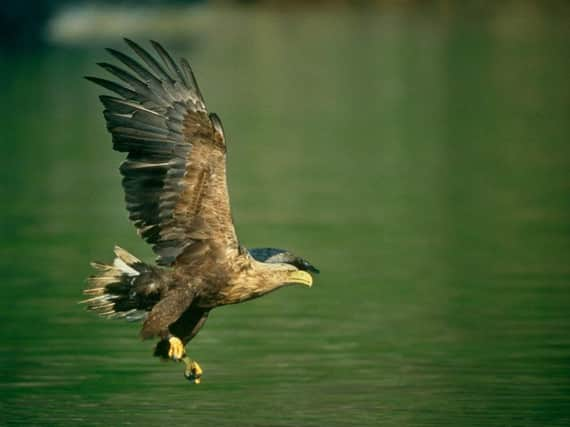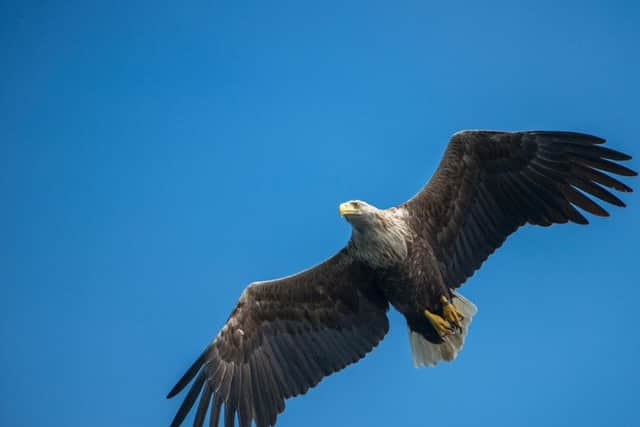Fears over eagles missing in north-east of Scotland


The young white-tailed eagles, which were fitted with satellite tags, were part of the first generation of chicks from a newly reintroduced population in eastern Scotland.
However, the tags ceased transmitting in “highly suspicious” circumstances on 22 July, with their last recorded locations over sport shooting estates.
Advertisement
Hide AdAdvertisement
Hide AdOne of the protected birds vanished in Inverness-shire, while the other was last tracked in Aberdeenshire.


Conservationists are appealing for information in a bid to find the young birds but have expressed concerns over their fate.
Ian Thomson, head of investigations for wildlife charity RSPB Scotland, said: “Yet again rare, protected birds of prey have disappeared in highly suspicious circumstances, with their last known locations on grouse moors.
“And yet again we can be almost certain that these birds have been killed, with those responsible destroying all the evidence.
“The disappearance of these two eagles is more than a loss of two birds; it means any future breeding success they might have had, helping to boost the numbers of these rare birds, has also been destroyed.
“Illegal persecution is seriously undermining the re-establishment of a white-tailed eagle population in this part of Scotland.”
The white-tailed eagle, also known as a sea eagle, is the country’s largest bird of prey.
The species went extinct in the UK during the early 20th century, due to illegal killing, and the present population is descended from reintroduced birds.
Advertisement
Hide AdAdvertisement
Hide AdThe largest concentration is found on the west coast of Scotland, but the birds have recently returned to the eastern part of the country through a reintroduction project run by RSPB Scotland, Forestry Commission Scotland and Scottish Natural Heritage between 2007 and 2012.
They are versatile and opportunistic hunters and carrion feeders, sometimes pirating food from other birds and even otters.
They eat largely fish, but also catch various birds, rabbits and hares.
White L was a male eagle tagged as a chick at a nest in in Fife in 2016. His tag last transmitted from a grouse moor a few miles from the Banchory to Fettercairn road, in Aberdeenshire.
The other chick fledged from a nest in Inverness-shire in 2018 and disappeared on managed moorland near Tomatin, in the northern Monadhliath mountains. As well as previous disappearances of satellite tagged eagles, this area has seen numerous incidents of shooting, poisoning and illegal trapping of eagles, red kites and hen harriers.
The National Wildlife Crime Unit and Police Scotland have been notified and provided with the tag data.
So far investigations by the police, including searches of the final known locations of the birds, have yielded no further information as to their fate.
Neither of the birds, nor their transmitters, have been found or heard from, leading to suspicions that they have been illegally killed.
Advertisement
Hide AdAdvertisement
Hide AdBut a spokesman for the Scottish Gamekeepers Association (SGA) said there needs to be "a degree of caution" when dealing with tag incidents.
“Satellite tags can and do fail," he said.
"They only give an indication of birds’ movements because there can be considerable time lapses in data being received.
“A bird can therefore travel a fair distance from the point the last known locational fix was sent, which makes searching often futile.
"We have seen cases where birds that have been given up for dead have later been located."
The SGA has petitioned the Scottish Parliament for independent monitoring of satellite tags by "neutral" experts.
Mr Thomson condemned illegal killing of birds of prey and repeated calls for regulation of the grouse shooting.
He said: “In 1999 Donald Dewar, Scotland’s first First Minister, described raptor persecution as a ‘national disgrace’, but 20 years on it continues unabated.
“It’s clear that current legal deterrents aren’t working.”